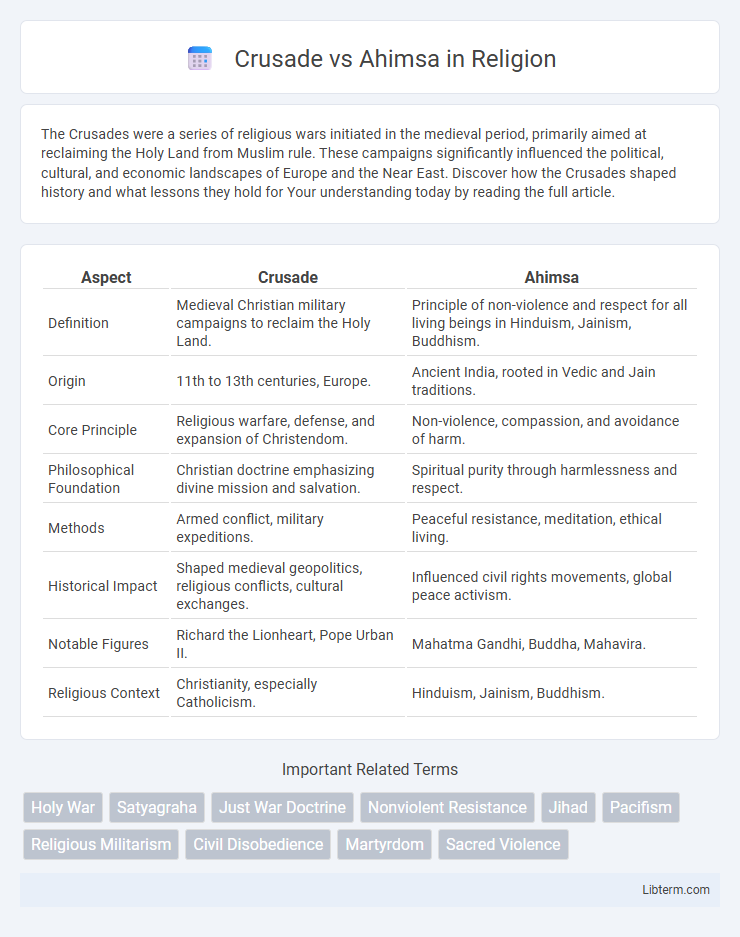The Crusades were a series of religious wars initiated in the medieval period, primarily aimed at reclaiming the Holy Land from Muslim rule. These campaigns significantly influenced the political, cultural, and economic landscapes of Europe and the Near East. Discover how the Crusades shaped history and what lessons they hold for Your understanding today by reading the full article.
Table of Comparison
| Aspect | Crusade | Ahimsa |
|---|---|---|
| Definition | Medieval Christian military campaigns to reclaim the Holy Land. | Principle of non-violence and respect for all living beings in Hinduism, Jainism, Buddhism. |
| Origin | 11th to 13th centuries, Europe. | Ancient India, rooted in Vedic and Jain traditions. |
| Core Principle | Religious warfare, defense, and expansion of Christendom. | Non-violence, compassion, and avoidance of harm. |
| Philosophical Foundation | Christian doctrine emphasizing divine mission and salvation. | Spiritual purity through harmlessness and respect. |
| Methods | Armed conflict, military expeditions. | Peaceful resistance, meditation, ethical living. |
| Historical Impact | Shaped medieval geopolitics, religious conflicts, cultural exchanges. | Influenced civil rights movements, global peace activism. |
| Notable Figures | Richard the Lionheart, Pope Urban II. | Mahatma Gandhi, Buddha, Mahavira. |
| Religious Context | Christianity, especially Catholicism. | Hinduism, Jainism, Buddhism. |
Understanding the Concepts: Crusade and Ahimsa
Crusade represents a militant campaign driven by religious or ideological zeal, often involving armed conflict to defend or spread specific beliefs. Ahimsa, rooted in Indian philosophy, embodies non-violence and compassion toward all living beings, advocating peaceful resistance and moral integrity. Understanding both concepts highlights the stark contrast between forceful confrontation and ethical non-violence as approaches to social and spiritual goals.
Historical Origins of Crusade and Ahimsa
The Crusades originated in the late 11th century as European Christian military campaigns aimed at reclaiming the Holy Land from Muslim control, rooted in papal calls for religious warfare and defense of Christendom. Ahimsa, a fundamental principle in Indian religions such as Hinduism, Buddhism, and Jainism, dates back to ancient Vedic texts around 1500 BCE and emphasizes non-violence and compassion towards all living beings. While the Crusades symbolize aggressive religious conflict, Ahimsa represents a spiritual commitment to peace and moral restraint, reflecting the divergent historical and cultural contexts of medieval Europe and ancient South Asia.
Philosophical Foundations: Violence vs Nonviolence
Crusade embodies a philosophy rooted in justified violence, often sanctioned by religious or ideological imperatives to defend or expand a belief system through force. Ahimsa, originating from Indian spiritual traditions like Jainism, Buddhism, and Hinduism, advances a strict ethical commitment to nonviolence, emphasizing respect for all living beings and the power of compassion. These opposing foundations shape divergent worldviews: one prioritizes active confrontation and moral duty through conflict, while the other advocates for peaceful resistance and harmony as paths to spiritual and social integrity.
Crusade: Motivations and Justifications
Crusades were driven by religious zeal, aiming to reclaim the Holy Land and defend Christendom against Muslim control, often justified by papal decrees promising spiritual rewards such as indulgences. The motivations included a mix of piety, desire for territorial expansion, and political power consolidation among European nobility. Justifications were grounded in the belief of a divine mandate to protect and spread Christianity, legitimizing warfare as a sacred duty.
Ahimsa: Principles and Practice
Ahimsa, rooted in ancient Indian philosophy, emphasizes non-violence and compassion towards all living beings, promoting peaceful coexistence and respect for life. Its principles advocate restraint from harm, forgiveness, and empathy, forming the ethical foundation of Jainism, Buddhism, and Hinduism. Practicing Ahimsa involves mindful actions and speech, encouraging conflict resolution through understanding and non-violent resistance.
Key Figures: Advocates of Crusade and Ahimsa
Key figures advocating the Crusade include Pope Urban II, who initiated the First Crusade in 1095, emphasizing religious warfare to reclaim the Holy Land. In contrast, Mahatma Gandhi stands as a prominent proponent of Ahimsa, promoting non-violent resistance and civil disobedience as tools for social and political change. These leaders symbolize the ideological divide between militant religious fervor and principled non-violence in historical struggles.
Societal Impact of Crusade Movements
Crusade movements significantly reshaped medieval European society by intensifying religious zeal and fostering a sense of collective identity centered around Christian expansionism. The mobilization for Crusades stimulated economic growth through trade routes connecting Europe and the Middle East, while simultaneously inciting widespread cultural exchanges and conflicts. These campaigns also precipitated long-lasting socio-political changes, including the strengthening of monarchies and the marginalization of certain minority groups, impacting societal structures for centuries.
Transformative Power of Ahimsa in Social Change
Ahimsa, rooted in nonviolence and compassion, holds transformative power in social change by fostering empathy and reducing conflict, ultimately enabling sustainable peace and justice. Unlike crusades that often rely on force and confrontation, Ahimsa inspires voluntary cooperation and moral awakening, leading to systemic shifts in societal values. Historical movements led by figures like Mahatma Gandhi demonstrate how Ahimsa effectively mobilizes mass participation and creates enduring social reform without resorting to violence.
Comparative Analysis: Outcomes of Crusade and Ahimsa
Crusades led to widespread religious conflict, territorial gains, and significant loss of life, reflecting a strategy driven by militant force and territorial expansion. Ahimsa, rooted in non-violence and compassion, facilitated social reform, spiritual growth, and peaceful resistance, notably influencing India's independence movement. The comparative outcome reveals that while Crusades imposed change through conflict, Ahimsa achieved lasting cultural and political transformation via ethical and non-violent means.
Modern Relevance: Choosing Between Crusade and Ahimsa
Modern relevance highlights the critical choice between Crusade and Ahimsa as strategies for social and political change. Crusade embodies direct action and assertive confrontation, often leveraging force or strong activism to achieve goals, whereas Ahimsa promotes nonviolence, compassion, and peaceful resistance as powerful tools for sustainable transformation. In contemporary movements, balancing the urgency of change with ethical considerations shapes the ongoing debate between adopting militant approaches or embracing pacifist principles to address injustice effectively.
Crusade Infographic

 libterm.com
libterm.com